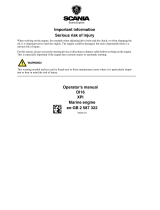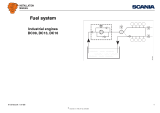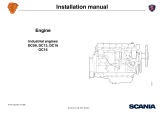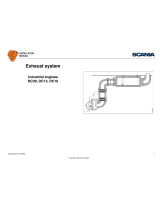Page is loading ...

01:03 OC Issue 3.0 en-GB
© Scania CV AB 2018, Sweden
Installation manual
Fuel system
Industrial engines
OC16
371 673

INSTALLATION
MANUAL
© Scania CV AB 2018, Sweden
01:03 OC Issue 3.0 en-GB 2
Changes from the previous issue............................................................................3
Fuel hose...................................................................................................................4
Gas regulator ...........................................................................................................4
Shut-off devices........................................................................................................7
Separating condensation.........................................................................................8
Safety precautions ...................................................................................................9

INSTALLATION
MANUAL
© Scania CV AB 2018, Sweden
Changes from the previous issue
01:03 OC Issue 3.0 en-GB 3
Changes from the previous issue
The changes made in this document compared with the previous issue are marked
with a line in the left-hand margin. The changes are also described below.
• Information on measuring the gas regulator supply pressure has been moved to
01:08 Measuring instructions for installation inspection.

INSTALLATION
MANUAL
© Scania CV AB 2018, Sweden
Fuel hose
01:03 OC Issue 3.0 en-GB 4
Fuel hose
Only the supplied fuel hose (1) from Scania may be used. The fuel hose is 1.5 m long.
The length must not be changed.
IMPORTANT!
No components apart from the fuel hose may be installed between the gas regulator
(2) and the gas connection on the engine. If other components are installed, this af-
fects the performance and ability to start of the engine.
Attach the fuel hose so that it does not rub against the charge air pipe.
The tightening torque of the nuts on both ends of the fuel hose is 50 Nm. The width
across flats of the nuts is 60 mm. Tighten the hose end against the gas regulator first
because the rotation of the fuel hose is greater on this end.
Gas regulator
Only the supplied gas regulator (2) from Scania may be used. The gas regulator must
not be installed on the engine as this may cause vibration damage.
Scania recommends that the fuel hose flows down from the gas regulator. Otherwise,
there is a risk of condensation water accumulating in the gas regulator.
1
2
371 674

INSTALLATION
MANUAL
© Scania CV AB 2018, Sweden
Gas regulator
01:03 OC Issue 3.0 en-GB 5
The gas regulator has the dimensions indicated in the illustration on the right and
weighs about 3.5 kg. The thread of the gas regulator intake (1) is Rp2 in accordance
with ISO 7/1. Install the gas regulator so that it can be removed and fitted easily.
IMPORTANT!
The supply pressure to the gas regulator should be between 20 and 35 mbar, irrespec-
tive of load and engine speed.
Suspend the gas regulator from a rigid pipe that is not engine-mounted. The weight
of the gas regulator must not load the fuel hose, as this could cause the fuel hose to
break.
The gas regulator may be installed vertically or horizontally, but not upside down.
1
310
450
200
47
250
393 932
Max 90
o
Max 90
o
371 676
Installation angle for gas regulator.

INSTALLATION
MANUAL
© Scania CV AB 2018, Sweden
Gas regulator
01:03 OC Issue 3.0 en-GB 6
Do not cover the ventilation hole (2) of the gas regulator.
1 2
371 677
1. Bleed nipple.
2. Ventilation hole.

INSTALLATION
MANUAL
© Scania CV AB 2018, Sweden
Shut-off devices
01:03 OC Issue 3.0 en-GB 7
Shut-off devices
The following requirements apply to the gas supply:
• There must be a manual shut-off cock for the gas supply, which should be acces-
sible without requiring the operator to go through a locked compartment.
• There must be at least one electric, normally closed shut-off valve which ensures
that the gas supply is shut off when the engine is not running. The shut-off valve
should be closed even when the 15 voltage is on.
You are normally required to have a shut-off valve with double functions or two
separate shut-off valves with leak testers. Comply with the applicable local laws
and regulations.
• The shut-off valves must follow seal integrity requirements according to local
laws and regulations.
• To ensure that the fuel system is free of gas, the engine must be shut down using
the installer's shut-off valves. The 15 supply to the engine control unit must not
be cut earlier than 5 seconds after engine shutdown to ensure that the fuel system
is free of gas.
Note:
The throttle at the gas mixer and the throttle at the flame arrestor do not function as
shut-off valves as they are not gastight.
1 2 3 4 4 6 7 9
58
A
372 553
Example of gas supply installation.
The components marked with an asterisk are included in the delivery from Scania.
1. Manual shut-off cock (mandatory).
2. Gas filter.
3. Gas regulator, low pressure.
4. Shut-off valves (1 shut-off valve is mandatory).
5. Leak tester.
6. Gas regulator, zero pressure.*
7. Gas mixer.*
8. Air filter.*
9. Engine.

INSTALLATION
MANUAL
© Scania CV AB 2018, Sweden
Separating condensation
01:03 OC Issue 3.0 en-GB 8
Separating condensation
If the fuel is not actively dried off, a condensation separator (1) should be installed
upstream of the gas regulator to ensure that no water enters the gas regulator or the
electric throttle.
1
374 159
Separating condensation in gas supply installation.

INSTALLATION
MANUAL
© Scania CV AB 2018, Sweden
Safety precautions
01:03 OC Issue 3.0 en-GB 9
Safety precautions
WARNING!
Both natural gas and biogas consist mainly of methane. Methane is flammable and
must be handled with great care.
IMPORTANT!
Comply with the applicable local laws and regulations when handling natural gas and
biogas. Work on the engine may only be carried out by staff who are aware of the
risks and have sufficient knowledge of natural gas and biogas.
Note:
Scania is not responsible for the gas supply system upstream of the gas regulator or
the leak test of the gas supply system.
When working on the fuel system and handling gas, observe the normal regulations
for handling gas:
• Any source of ignition must be kept away from or be screened from the area. Ex-
amples of circumstances which could cause ignition are welding, smoking, grind-
ing with grinding machines, sparks from static electricity or electrical equipment.
• The ventilation in the engine compartment must be satisfactory for the evacuation
of gas. See 01:02 Intake system.
/











